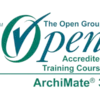ArchiMate® 3 Practitioner (level 1 & 2)
The ArchiMate® 3 Enterprise Architecture modeling language provides a uniform representation for diagrams that describe Enterprise Architectures. It comprises language customisation tools, viewpoint specifications for specific stakeholders, and principles for defining interrelated architectures. It explains many architecture domains, their underlying relationships, and their dependencies, and brings them to life through visualization.
Overview
An enterprise architecture modeling language called ArchiMate was created to make it easier to describe and illustrate architectural ideas and features. It offers a degree of clarity necessary for making well-informed judgments, and practitioners may collaborate and communicate much more easily because to its common terminology. For career enterprise architects, ArchiMate is a very useful modeling tool that is frequently used in conjunction with TOGAF.
What you will learn in ArchiMate® 3 Practitioner (level 1 & 2) course?
- The concepts, language structure, and relationships that make up the framework
- How to utilize the Business, Application, and Technology layers
- Elements relating to motivation, strategy, implementation, migration, and physical resources
- How the framework treats stakeholders
- The role of cross-layer dependencies in linking businesses, applications, and technology
- How to customize the ArchiMate language to suit individual projects and organizations
- Everything required to sit and pass the ArchiMate 3 Foundation and Practitioner examinations
Who Should Attend ArchiMate® 3 Practitioner (level 1 & 2) course?
- Individuals who require a practical understanding of the ArchiMate 3.1 modeling language
- Individuals responsible for developing enterprise architecture artifacts and architecture program diagrams using the ArchiMate language notation
- Organizations hoping to improve the efficiency and clarity of their enterprise architecture practices
- Individuals who want to achieve ArchiMate 3 certification to demonstrate their practical understanding of the modeling language
- Anyone wanting to pass the official ArchiMate Foundation and ArchiMate Practitioner examinations as efficiently as possible
Our Package
Learning Objectives
In this opening module, we look at what the ArchiMate standard provides to the business, as well as why it is important to the Enterprise Architecture practitioner and the organization.
We introduce the key characteristics of the framework and offer a brief history of the standard since its conception in 2002.
Finally, we examine The Open Group and how ArchiMate harmonizes with the organization’s other standards, including TOGAF.
Learning Objectives
In this module, we take a look at the Open Group’s ArchiMate 3 Certification Program. We learn that it offers certification in three key areas: people, products, and ArchiMate training courses.
The certification for people program uses two levels: Foundation (Level 1) and Practitioner (Level 2). We take an in-depth look at the certification requirements needed for Level 1 and Level 2, as well as the examination conditions and pass marks.
Learning Objectives
This module introduces the basic concepts of Enterprise Architecture and the ArchiMate language.
We will be looking at the purpose and benefits of Enterprise Architecture, the ArchiMate standard’s relationship with Enterprise Architecture, the architectural domains covered by the standard, and how they map with TOGAF.
We also discuss the positioning of the ArchiMate framework with other modeling languages and modeling concepts.
Learning Objectives
In Module Four, “Language Structure”, we begin by looking at the framework’s design considerations and top-level language structure, moving on to its layers and framework.
We complete the topic with studies of abstraction, concepts and notations, nesting, use of color, and notational cues.
Learning Objectives
In this module, we will take a closer look at the ArchiMate generic metamodel and then turn our attention to relationships. When dealing with the metamodel, we will cover Behavior and Structure Elements as well as Specializations.
We will also study Motivation Elements, Strategy Elements, and Composite Elements.
In addition to the generic elements outlined in Module five, the ArchiMate language also defines a core set of generic relationships. Each of these relationships can connect a predefined set of source and target concepts.
This module covers the core ArchiMate relationships, including Structural, Dynamic, Grouping, Junction, and Specialization relationships.
Learning Objectives
In module seven, we look at both the Motivation and Strategy Elements in ArchiMate 3.
We will start by looking at the Motivation elements, which are used to model the motivations or reasons that guide the design or change of an Enterprise Architecture.
We will begin with the Stakeholder, Driver, and Assessment elements, followed by Goal, Outcome, Principle, Requirement, and Constraint, before concluding our study of the Motivation Elements with Meaning and Value.
We will then turn our attention to the Strategy Elements, namely Resource, Capability, and Course of Action.
Learning Objectives
In this module, we will explore the elements that make up the business layer in the ArchiMate Framework. The elements can be split into the active, behavior, and passive aspects. Other elements also fall into the composite category.
Learning Objectives
This module will explore the elements that make up the application layer in the ArchiMate Framework.
Learning Objectives
In module 10, we will explore the elements that make up the Technology layer in the ArchiMate Framework.
Learning Objectives
In module 11, we look at the physical elements, namely the Active Structure elements Equipment, Facility, and Distribution Network, the Behavior elements, and the Passive Structure Element (‘Material’).
Learning Objectives
A central issue in Enterprise Architecture is business-IT alignment and how these layers can be matched. This module describes the relationships that the ArchiMate language employs to denote this alignment, as well as the links between business, applications, and technology.
Learning Objectives
In this module, we look at the Implementation and Migration Elements and their Relationships.
We define a number of Implementation and Migration elements. We also study Relationships and Cross-aspect Dependencies.
Learning Objectives
The ArchiMate language provides a flexible approach in which architects and other stakeholders can use their own views on the Enterprise Architecture. In this approach, views are specified by viewpoints.
Viewpoints define abstractions on the set of models representing the Enterprise Architecture, each aimed at a particular type of stakeholder and addressing a particular set of concerns.
Viewpoints can be used to view certain aspects in isolation and to relate two or more aspects. In this module, we will address Stakeholders and Concerns, Views and Viewpoints, The Viewpoint Mechanism, Defining and Classifying Viewpoints, and Creating the View.
Learning Objectives
The ArchiMate language contains the basic elements and relationships that serve general EA modeling purposes only.
However, the language should also be able to support other, more specific, purposes, such as types of model analysis, the communication of architectures, and those of a certain domain (for example, the financial sector).
We therefore need a means of customizing the language, without burdening it with a lot of additional material. This module is therefore devoted to the customization mechanisms in ArchiMate 3.
Learning Objectives
This module will briefly explain how ArchiMate Certified Tools can be used to support EA modeling and analysis with ArchiMate 3.
Upcoming Batch
April 20th (Weekends)
FRI & SAT (4 Weeks)
08:30 PM to 01:00 AM (CDT)
April 18th (Weekdays)
MON – FRI (18 Days)
10:00 AM to 12:00 PM (CDT)
ArchiMate® 3 Practitioner (level 1 & 2) FAQs
ArchiMate helps enterprise architects by giving them a graphical language for planning, creating, and presenting architectures.
ArchiMate models can also range in complexity, allowing users to create different versions of the same architecture for audiences with varying levels of knowledge.
ArchiMate essentially provides users with a set of instructions for visually communicating EA concepts. These models are far easier to interpret than most enterprise architecture frameworks, giving stakeholders the perspective to make the best decisions possible.
The framework can be used by anyone with knowledge of enterprise architecture, though it is most often utilized by TOGAF practitioners.
ArchiMate certifications can be extremely advantageous for career enterprise architects. Not only can it help them utilize frameworks like TOGAF, but it can also create networking opportunities and help them win roles with higher pay and more responsibilities.
The ArchiMate Foundation exam is closed-book, consists of 40 questions, lasts 60 minutes, and has a pass mark of 60%.
The ArchiMate Practitioner exam is open-book, features eight questions, lasts 90 minutes, and has a pass mark of 70%.






Reviews
There are no reviews yet.